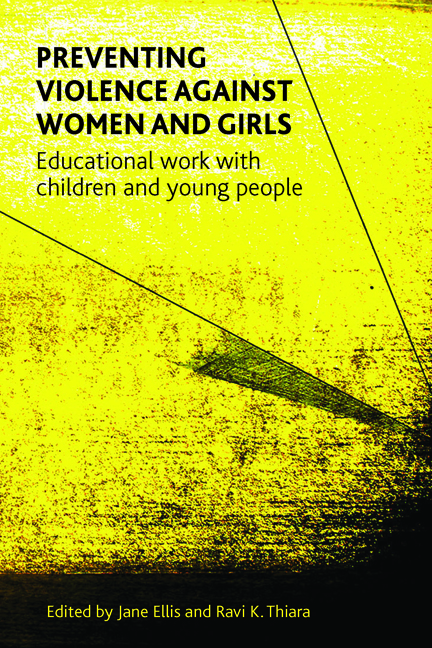Book contents
- Frontmatter
- Dedication
- Contents
- List of tables and figures
- Notes on contributors
- Acknowledgements
- Foreword
- Introduction
- one Preventing violence against women and girls through education: dilemmas and challenges
- two Does gender matter in violence prevention programmes?
- three Responding to sexual violence in girls’ intimate relationships: the role of schools
- four ‘Pandora’s Box’: preventing violence against black and minority ethnic women and girls
- five Preventing violence against women and girls: a whole school approach
- six What did you learn at school today? Education for prevention
- seven No silent witnesses: strategies in schools to empower and support disclosure
- eight Preventing sexual violence: the role of the voluntary sector
- nine ‘Boys think girls are toys’: sexual exploitation and young people
- ten MsUnderstood: the benefits of engaging young women in antiviolence work
- eleven Shifting Boundaries: lessons on relationships for students in middle school
- Concluding remarks
- Appendix: Examples of programmes in the UK
- Index
three - Responding to sexual violence in girls’ intimate relationships: the role of schools
Published online by Cambridge University Press: 04 March 2022
- Frontmatter
- Dedication
- Contents
- List of tables and figures
- Notes on contributors
- Acknowledgements
- Foreword
- Introduction
- one Preventing violence against women and girls through education: dilemmas and challenges
- two Does gender matter in violence prevention programmes?
- three Responding to sexual violence in girls’ intimate relationships: the role of schools
- four ‘Pandora’s Box’: preventing violence against black and minority ethnic women and girls
- five Preventing violence against women and girls: a whole school approach
- six What did you learn at school today? Education for prevention
- seven No silent witnesses: strategies in schools to empower and support disclosure
- eight Preventing sexual violence: the role of the voluntary sector
- nine ‘Boys think girls are toys’: sexual exploitation and young people
- ten MsUnderstood: the benefits of engaging young women in antiviolence work
- eleven Shifting Boundaries: lessons on relationships for students in middle school
- Concluding remarks
- Appendix: Examples of programmes in the UK
- Index
Summary
The primary focus of this chapter is to explore girls’ experiences of sexual victimisation in their intimate relationships and to provide messages for school-based responses. By concentrating on female victimisation, we do not wish to imply that boys’ experiences of intimate violence are any less worthy of attention. However, research using self-reports on the effects of violence (both physical and emotional) indicate that boys report fewer, less serious impacts to their welfare than girls do (Barter et al, 2009). This is especially true in relation to sexual violence. In addition, studies indicate that violence carried out by girls; is often a direct response to their own victimisation (Cook and Swan, 2006; Allen et al, 2009). If a large proportion of violence carried out by girls is a response to their partners’ initial aggression, by reducing violence carried out by boys we will inevitably also reduce girls’ use of retaliatory violence.
So how significant a problem is intimate sexual violence against girls? Previous national and international findings on intimate sexual violence provide contrasting results although all testify to its significance. Estimates of sexual coercion and violence range from 4% to as high as 80% although most studies consistently show that girls are most likely to be victims and males perpetrators (Lane and Gwartney-Gibbs, 1985; Muehlenhard and Linton, 1987; Gamache, 1991; Silverman et al, 2001, Ackard et al, 2003). Muehlenhard and Linton (1987) report that 15% of their sample had been rape victims and that nearly 80% had experienced some form of unwanted sexual activity from their boyfriends, mostly forced kissing and touching. A Scottish survey of 14 to 18 year-olds found that 10% of girls and 8% of boys said their partners had tried to force them to have sex. However, Ackard (2003) found that 4% of adolescent girls reported being physically forced into sexual contact by an intimate partner. This wide variation reflects in part a definitional problem of what encompasses sexually aggressive acts as well as sampling issues, primarily the diverse, and therefore incompatible, age groups under investigation. Our research sought to overcome this methodological dilemma by including a range of survey questions on specific aspects of sexual violence and analysing responses both by individual acts and also by a combined category of sexual violence.
Research studies
This chapter is based on two related research projects. The first study used a multi-method approach (Barter et al, 2009).
- Type
- Chapter
- Information
- Preventing Violence against Women and GirlsEducational Work with Children and Young People, pp. 65 - 84Publisher: Bristol University PressPrint publication year: 2014
- 1
- Cited by



